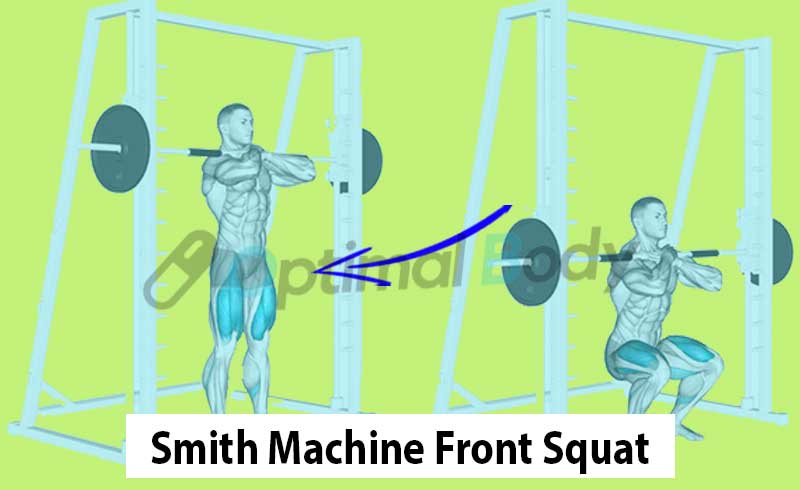When it comes to building strong and impressive legs, the Smith machine front squat stands out as a game-changer.
Unlike traditional free weight front squats, the Smith machine variant offers unique benefits that can supercharge your leg workouts and take your gains to the next level.
In this article, we’ll dive into:
- What are Smith machine front squats
- Their Benefits
- How to perform them
- Exercise tips
- Variations and alternatives
The Smith Machine Front Squat Advantage:
Ask any seasoned bodybuilder or fitness enthusiast, and they’ll likely tell you that machine front squats are among the most effective leg exercises you can incorporate into your leg routine.
What makes them so special? Let’s break it down:
1. Targeted Quad Development:
Smith machine front squats place a relentless focus on your quadriceps, ensuring they take center stage during your workout.
Unlike the regular front squat, where the upper back and core can often become limiting factors, Smith machine front squats isolate your quads, making each repetition count.
2. Enhanced Stability:
One of the key benefits of the Smith machine is its built-in stability.
With the barbell guided along a fixed path, you can confidently lift heavier weights without worrying about balance.
This stability is particularly beneficial when performing front squats, allowing you to maximize your quad engagement.
Benefits Beyond Muscle Growth:
Smith machine front squats offer benefits that extend beyond muscle growth:
- Stronger Mind-Muscle Connection: With the balance factor removed, you can concentrate entirely on targeting your quads, leading to a stronger mind-muscle connection and better results.
- Healthier Lower Back: Unlike back squats, the front squat places less stress on the lower back, reducing the risk of injury.
- Less Knee Strain: They are safer for the knees, offering the same quad stimulation with reduced risk. Proper form is essential for knee health.
- Improved Lifting Technique: Front squats demand proper form, reinforcing good lifting habits that carry over to other exercises.
- Safer Quad Training: It provides safety catches, allowing you to train to failure without safety concerns.
Muscles Worked:
Smith machine front squat engages several muscle groups, including:
- Quadriceps: Smith machine front squats intensely target the quadriceps, making them a top choice for quad development.
- Glutes: While the emphasis is on the quads, the glutes also play a role in the movement.
- Upper Back: The upper back is involved in stabilizing the bar during front squats. Smith machine front squats require less upper back engagement compared to free weight front squats, allowing for better isolation of the quads.
- Spinal Erectors: These muscles are isometrically engaged during deep squats, though to a lesser extent in Smith machine front squats.
- Abdominals: this exercise requires less core stability than their free weight counterparts, allowing for greater focus on quad development.
How To Do Smith Machine Front Step By Step
Now that we’ve explored the benefits, let’s walk through the proper technique for performing Smith machine front squats:
- Bar Placement: Set the Smith machine bar just below shoulder height, slightly lower than you would for back squats.
- Foot Position: Stand under the bar with your feet positioned approximately shoulder-width apart. Avoid narrowing your stance too much, as this can limit your range of motion.
- Arm Position: Extend your arms forward until your shoulders touch the bar. Maintain a 90-degree angle between your upper arms and torso.
- Cross Your Arms: Cross your arms, placing each hand on the opposite shoulder.
- Foot Flare: Turn your feet outward at an angle of 15 to 30 degrees.
- Lift Off: Squat to lift the bar off the hooks, ensuring that your elbows remain parallel to the ground. Avoid leading with your hips; instead, initiate the movement with your knees and hips together.
- Squatting Motion: Inhale, brace your core, and sit down while pushing your knees outward. Aim to break parallel with your squat, and then explosively push through your entire foot to ascend.
- Repetitions: Repeat the exercise for 3-5 sets, with a rep range of 6-15.
Pro Tips:
To maximize the effectiveness and safety of your Smith machine front squats, consider these expert tips:
1. Experiment with Grips:
While the clean grip is secure for dumbbell squat, it can be tough on the wrists.
The Smith machine eliminates this concern, but it’s worth trying both grips to find your preference.
If using a clean grip, consider wrist wraps for added support.
2. Break at Knees and Hips Together:
Start the squat by breaking at your knees and hips simultaneously. Avoid breaking at the hips first, as this can lead to balance issues.
3. Maintain High Elbows:
Keeping your elbows high is crucial for proper front squat form, it relies on core strength and a straight upper back.
This practice is easier to maintain on a Smith machine but is valuable to master regardless.
4. Strengthen Your Upper Back:
Since the upper back plays a vital role in stabilizing the bar during the front squat, incorporate exercises like rows and face pulls to strengthen it.
This will enhance your front squat performance and help you build a more balanced physique.
Related: How To Do A Front Cable Squat Properly?
Smith Machine Front Squat Variations
Here are some variations that maintain the essence of the Smith Machine Front Squat with slight modifications:
1. Smith Machine Front Close-Stance Squats
This variation places more emphasis on your quadriceps and inner thighs.
How to Do It:
- Position your feet closer together, narrower than shoulder-width apart.
- Perform the Smith Machine Front Squat as usual with the closer stance.
2. Pause Rep Smith Front Squat
Pausing at the bottom increases time under tension and can lead to greater muscle engagement.
How to Do It:
- As you perform the Smith Machine Front Squat, pause for a few seconds at the bottom of the squat, where your thighs are parallel to the ground.
- Then, push back up to the starting position.
3. Smith Machine Zercher Squat
How to Do It:
- Stand inside the Smith machine with the bar set at a height just below shoulder level.
- Position yourself so that the bar is in the crook of your elbows, with your hands facing upward.
- Stand with your feet shoulder-width apart.
- Lower your body by bending your knees and hips while keeping the bar in the crook of your elbows.
- Go as low as you can while maintaining your balance.
- Push through your feet to stand back up.
4. Smith Machine Frankenstein Squat
The bar’s angled position allows for a more vertical squat motion, targeting the quads.
How to Do It:
- Stand inside the Smith machine with the bar set at a height just below shoulder level.
- Grasp the bar with an overhand grip, hands positioned wider than shoulder-width apart.
- Stand with your feet shoulder-width apart.
- Lower your body by bending your knees and hips while keeping the bar in front of you.
- Go as low as you can while keeping the bar close to your body.
- Push through your feet to stand back up.
Smith Machine Front Squat Alternative Exercises:
While Smith machine front squats are incredibly effective, consider these alternatives to diversify your leg training:
1. Smith Machine Back Squat:
A potent mass-builder, Smith machine back squats offer a different angle for leg development and are ideal for powerlifting-style training.
How to Do It:
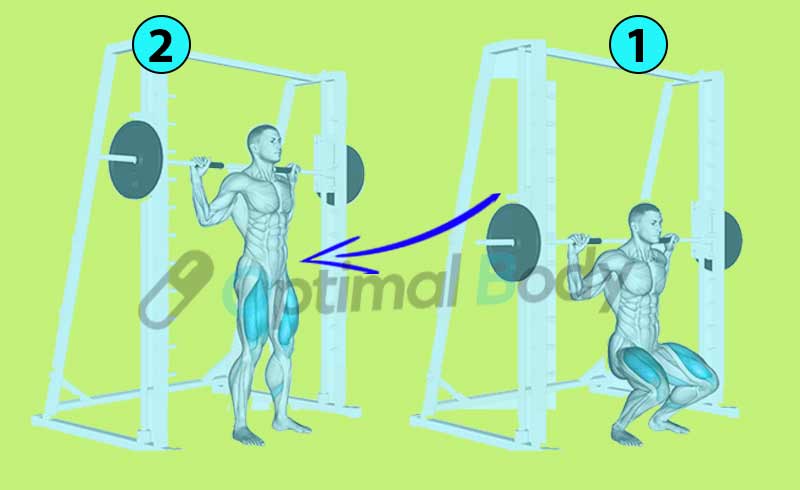
- Stand under the Smith machine bar with your feet shoulder-width apart.
- Place the bar on your upper back and shoulders, holding it securely.
- Lower your body by bending your knees and hips simultaneously.
- Go as low as you can, ideally until your thighs are parallel to the ground.
- Push through your feet to stand back up.
Tips:
- Keep your back straight and chest up.
- Don’t let your knees go past your toes.
Goblet Squat
A Goblet Squat is a type of squat exercise that involves holding a dumbbell or kettlebell close to your chest while performing a squat.
How to Do It:
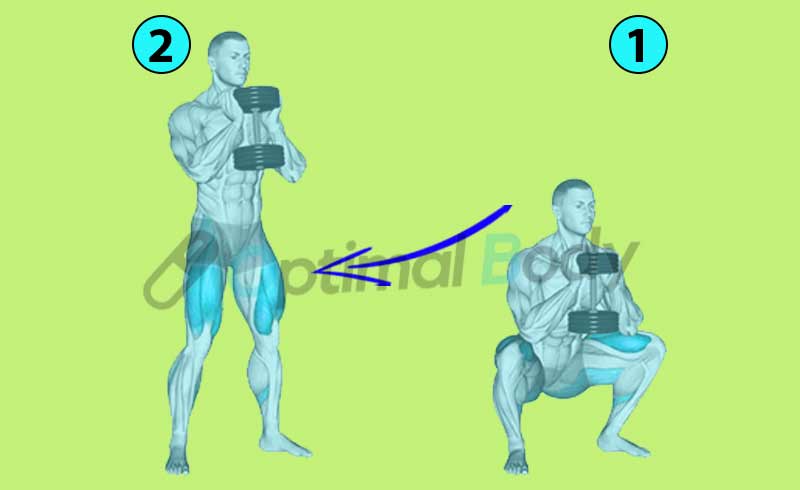
- Hold a dumbbell or kettlebell close to your chest with both hands.
- Stand with your feet shoulder-width apart.
- Lower your body by bending your knees and hips simultaneously.
- Go as low as you can while keeping your back straight.
- Push through your feet to stand back up.
Tips:
- The weight in front of your chest helps with balance.
- Keep your chest up throughout the exercise.
Smith Machine Hack Squat:
Mimicking the hack squat machine, this exercise targets the quads and provides an alternative to traditional front squats.
How to Do It:
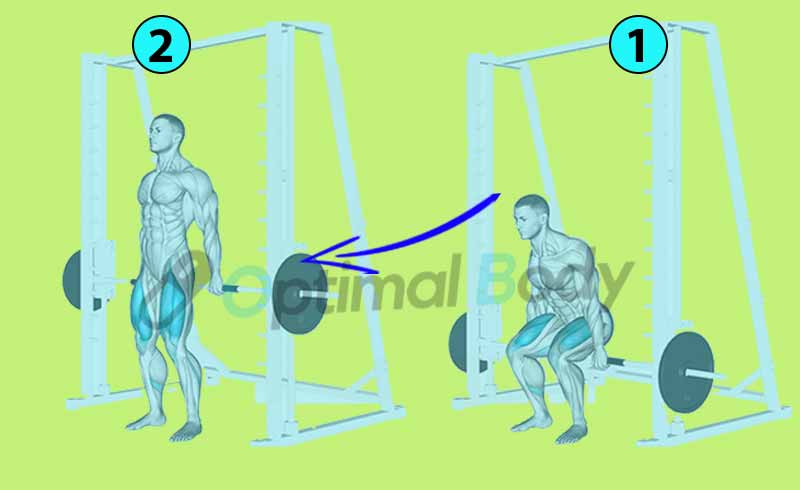
- Stand in front of the Smith machine with your feet shoulder-width apart.
- Position the bar on your shoulders and upper back.
- Bend your knees to lower your body, keeping your back straight.
- Go as low as you comfortably can.
- Push through your feet to stand back up.
Tips:
- Focus on keeping your back against the machine’s padding.
- Don’t let your knees collapse inward; keep them in line with your feet.
- Use proper form before increasing the weight.
Barbell Front Squat:
Athletes and weightlifters may opt for barbell front squats to build core strength and improve Olympic lifting performance.
How to Do It:
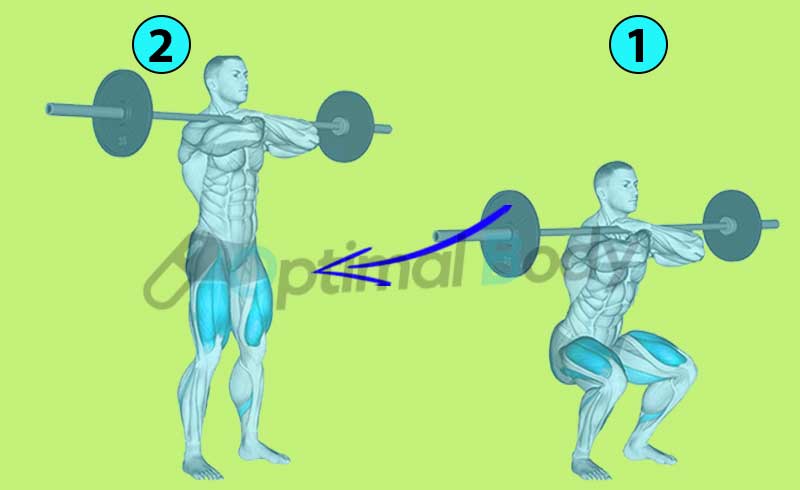
- Start by holding a barbell across the front of your shoulders.
- Keep your elbows up and in front of you to support the bar.
- Stand with your feet shoulder-width apart.
- Bend your knees and hips at the same time to lower your body.
- Go as low as you can, aiming for your thighs to be parallel to the ground.
- Push through your feet to stand back up.
Tips:
- Maintain high elbows throughout the exercise to keep the bar stable.
- Focus on a straight back and an upright posture.
- Practice with light weights initially to master the technique.
These alternatives to the Smith front squat offer different ways to work your leg muscles. The Smith machine back squat emphasizes overall leg strength, the Smith machine hack squat targets the quads, and the barbell front squat is great for core strength.
Front Squat Vs Back Squat On Smith machine
Let’s compare the Front Squat and Back Squat using the Smith Machine to help you understand the differences:
Muscle Emphasis:
- Front Squats with the Smith Machine primarily target the quadriceps, with some engagement of the core.
- Back Squats with the Smith Machine work a broader range of leg muscles, including the quadriceps, hamstrings, and glutes.
Bar Placement:
- In Front Squats, the bar is placed in front of your neck and shoulders, requiring you to maintain an upright posture and keep your elbows high.
- In Back Squats, the bar rests on your upper back and shoulders, allowing you to lean forward slightly during the movement.
Safety and Stability:
- Both exercises provide stability due to the Smith Machine’s guided bar path, reducing the risk of balance issues.
- The Front Squat might be considered safer for the lower back because it places less stress on this area compared to the Back Squat.
Variety and Training Goals:
- Including both Front Squat and Back Squat with the Smith Machine in your workout routine can offer variety and help you target different leg muscles.
- Your choice between the two may depend on your specific training goals and preferences.
FAQs
Are front squats on Smith machine good?
Yes, Smith machine front squats provide stability, reducing balance challenges. They also place less stress on the lower back and emphasize quadriceps, making them beneficial for certain fitness goals.
What are the benefits of squats on the Smith machine?
Squats on the Smith machine provide safety, isolate muscles, add workout variety, aid rehabilitation, allow controlled progression, and reduce spinal compression compared to free-weight squats, making them a versatile addition to your fitness routine.
Why does Smith machine squat harder?
Smith machine squats can be perceived as harder because they have a fixed bar path, reduce muscle engagement, limit stabilization, and may lack functional transfer to real-life movements, making them challenging, especially for those used to free-weight squats.
References:
- 15, , , et al. Finite element analysis of a healthy knee joint at deep squatting for the study of tibiofemoral and patellofemoral contact. J Orthop. 2023; 40: 7–16.
- Myer, G. D., Kushner, A. M., Brent, J. L., Schoenfeld, B. J., Hugentobler, J., Lloyd, R. S., Vermeil, A., Chu, D. A., Harbin, J., & McGill, S. M. (2014). The back squat: A proposed assessment of functional deficits and technical factors that limit performance. Strength and conditioning journal, 36(6), 4–27. https://doi.org/10.1519/SSC.0000000000000103
- Bench Press Calculator - April 22, 2024
- Press to Handstand: Ultimate Step-by-Step Guide - April 22, 2024
- Cable Press (How To Do, Benefits, Targeted Muscles, Alternative) - April 22, 2024

